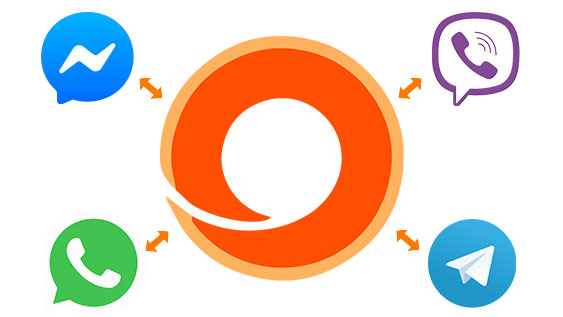

The Benefits of Texting Prospective Students (with Examples)
Is Texting Prospective Students an Answer to Lagging Enrollment?
More colleges and universities are embracing the benefits of admissions texting to establish a stronger relationship with current and prospective students. Competition is fierce, and institutions are searching for any way possible to boost enrollment. A higher-ed texting platform is a simple and powerful communication tool that can set a school apart from the competition by meeting students where they already are.
Ever since college enrollment rates throughout the mid-to-late 1900s continually rose before breaking the 20 million mark in 2009, they’ve been oscillating up and down, leaving significant doubts about future trajectories. While enrollment has handily recovered from the drastic two-million decline amidst the 2020 shutdowns, other issues are at play, such as waning faith in degrees, rising student mental health challenges, and increasing tuition costs.
To be sure, admissions texting with prospective students isn’t a panacea for the multi-faceted issues affecting college enrollment — but it is a highly effective and affordable way of keeping up with the fastest-changing trends in consumer behavior. Further, as we’ll cover below, it may save at-risk students from permanently drifting off course.
Where to Go From Here
Many prospective students skip higher education, opting for an online certification course, jumping straight into the job market, or taking a gap year (or years). As time has shown, it doesn’t matter so much to them when studies show that abandoning degrees is financially detrimental in the long term — many are seeing evidence of the declining value of traditional degrees. When they see more immediately valuable credentials that they can obtain in a fraction of the time and cost, what is the wisest response for tech-savvy admissions boards?
One light that higher education institutions should not lose sight of is that they are well-positioned to get out in front of an increasingly mobile-centric student base. As even leading colleges and universities try redefining themselves, the time is now to leverage the most advanced and responsive communications strategies.
Investing in improved outreach touchpoints is the key to ensuring any contact with students generates the most positive experience and leads to higher admissions rates. They’re already accustomed to businesses offering more accessible and faster customer support methods and making their purchasing decisions accordingly. With far more significant investments, such as formal college education, equally or more fluid outreach strategies should be adopted by college admissions staff as soon as possible.
Fortunately, these technologies are user-friendly, enabling a small portion of admissions staff to manage a faster, more effective, and far more relevant communications channel. They also align perfectly with the need for colleges to lower operating costs, as software-based texting is highly affordable and easily scalable. Further, governing and corporate telecom bodies have eased restrictions on the use of Application to Peer (A2P) technologies that can make this all happen.
Meeting Your Future Students Where They Are Now
It’s no secret that today’s college-aged populations have made phone usage a significant part of their lifestyle. As a result, text messaging is now essential for engaging with students and prospects in real-time to increase enrollment, improve retention, and produce higher graduation rates.
According to a recent market research report highlighting studies by leading text-marketing firms, over 90% of texts are read in three minutes or less and have a 98% open rate. This drastically outmatches engagement metrics through any other communications medium — and response rates, conversions, and customer satisfaction are also much higher with SMS.
Contextually, it’s essential to realize why these trends are occurring. High school juniors and seniors receive a veritable onslaught of information as they prepare for graduation and future life plans. With so much digital competition for attention, any communication that fails to engage with an already busy audience and per their preferences will go from their to-do list to the digital dustbin. Even for students who are already highly interested, brief and timely notifications through their preferred medium help them stay on track as easy-to-miss deadlines quickly mount.
In response, universities must implement enterprise-grade, scalable texting systems to interact with today’s student base effectively. The best higher-ed texting platforms allow university administrators to create instant two-way conversations and mass notifications to remind prospects about deadlines and other essential university information. The fastest-growing universities are already using admissions texting to engage current and prospective students for the following purposes:
- Increasing response rates
- Boosting admissions numbers
- Promoting student and career services
- Easing financial aid and other application burdens
- Facilitating one-on-one conversations with counselors
How Colleges Use Admissions Texting to Increase Student Enrollment and Improve Retention
Texting prospective students with notifications and alerts ensures they see urgent or time-sensitive information and have valuable resources at their fingertips, and it’s exceptionally well received. Research shows that over three-quarters of students want to receive relevant information via text, and an astonishing 85% find text messaging helpful for remembering important dates and deadlines.
Mass Text Notifications
Mass SMS notifications require short codes (5-6 digit shortened phone numbers) instead of long codes (10-digit phone numbers). Short codes are unique numbers designated by wireless carriers to send large numbers of simultaneous text messages for urgent alerts, opt-in SMS marketing campaigns, and other mass notifications. Using long codes for mass texting will cause messages to be flagged and blocked as spam, and a user-friendly higher-ed texting platform will help you keep your short codes and long codes separate and used appropriately.
Related: Long Code vs. Short Code Texting: Which Is Right for Your Business?
Below are examples of mass text notifications colleges send to prospective students. Institutions can easily personalize these notifications with unique student information, such as name, appointment dates, and interests, but only if your texting platform is built to integrate with CRM or SIS software or web services. A more cohesive and streamlined workflow for your staff will inevitably lead to a more cohesive experience for your audience at the other end.
Application Reminders
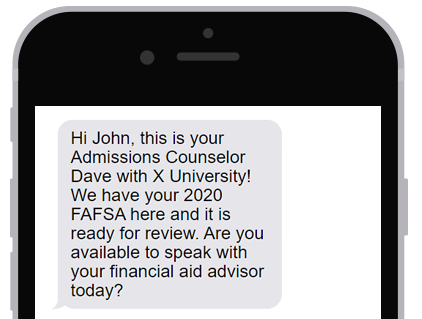

With so many applications to complete and deadlines to remember, it’s easy for applicants to forget when every form is due. Make it easy for prospective students to boost your admissions rates by sending reminders of critical due dates. Be sure to include links within the message to the relevant forms and application portals to facilitate faster and on-time completion.
Encouraging Social Media Participation
The more prospective students engage with a school they’re interested in, the more likely they are to apply. Creating a social buzz can increase these odds by encouraging them to meet like-minded individuals and form crucial connections, an essential element for influencing student decisions. You can easily share social participation with your student alums and campus groups via subscription pages and invitations to join and follow your channels via text.
Promoting Campus Tours
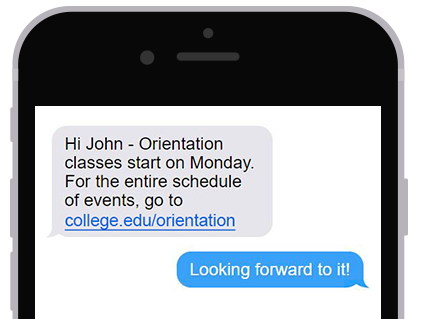

Even after generating initial interest, it takes significant effort and marketing dollars to motivate physical action toward admissions. The most effective solution is to invite prospects to sign up for a campus tour with a registration link. Remember that prospective students often sign up for several campus tours, so make sure they feel welcome and know what to do next. Texting prospective students with a quick, well-placed update with their scheduled tour date, time, address, and contact liaison can dramatically increase tour attendance.
Scholarship Opportunities
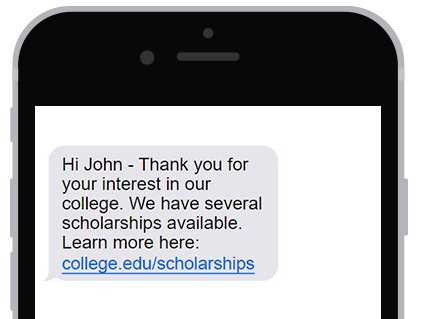

Scholarships easily capture the interest of prospective students, especially with rising tuition costs. Send prospects a quick text message promoting scholarship options, and ensure they see the financial incentives available. This will also increase interest from your sponsors to continue funding scholarships when they see higher proactivity through admissions texting strategies that raise the number of scholarship applicants.
Promotional Event Notifications
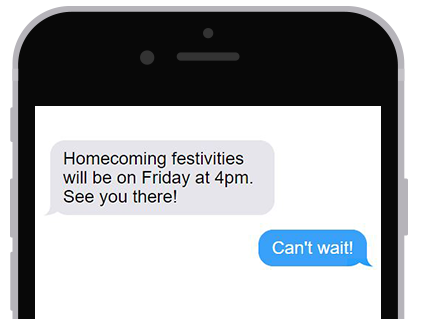

Galvanize your school’s sense of community with students and parents by promoting social events held at the school, including sporting events, art fairs, performances, and open houses. Text message reminders immediately boost event attendance rates — prospective students who missed one-on-one appointments may respond better to open invitations.
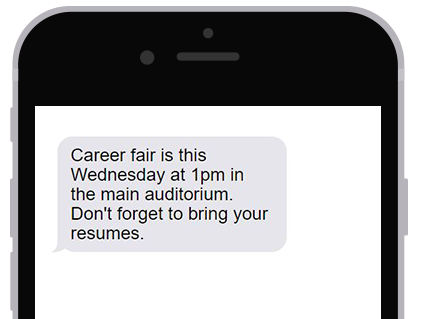

SMS channels just as effectively promote off-campus events, such as high school college fairs, booths at public community events, and other unique sponsorship opportunities. Invite people to meet with college admission reps and ask any questions they might have, showing how ingrained your school is in the community. These are also the perfect times to promote giveaways, raffles, or contests.
General Marketing Messages
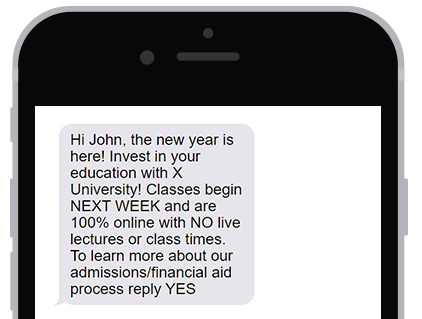

Text prospective students strategically timed and personalized promotions highlighting the benefits of enrolling. Keep the message short, and allow the contact to quickly learn more by responding directly to the message — but also be as straightforward as possible about the limits of general advertising through telephone devices according to consent laws. Your preferred text-management platform can help you heed relevant legal standards by accurately keeping track of individual user-consent levels and streamlining your opt-out process for maximum audience satisfaction.
Transitioning Promotions to Conversation
In most cases, text notifications, promotions, and reminders can quickly morph into the communication that most effectively builds rapport: fluid, two-way conversation. This is where the 10-digit long codes (10DLC) come in: phone numbers that facilitate text and voice with your subscribers.
Texting is conversational by nature, and it’s at its best when you leverage it for personal engagement that shows your commitment to their specific needs. This is particularly crucial for students most vulnerable to the “summer melt” effect, where 10–40% of seniors seemingly on track to college enrollment drift away.
A prolific texting research study on the phenomenon found that 86% of students reported admissions texting prompted them to complete a task they hadn’t finished. As simple as that sounds on the surface, when it comes to such a crucial, life-changing point in time, the significance that a single thoughtfully timed text message can have on someone’s life can be truly remarkable.
Admissions Questions
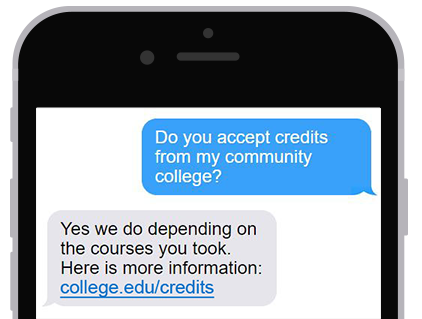

It’s natural for prospective students to have numerous questions. Make it easy to do so through admissions texting instead of relying exclusively on emails and voicemails, frequently lost in the shuffle. Losing valuable opportunities to connect more effectively results in prospective students moving on to other choices, which in this case, means an entirely different life path. Let students know they can text you by promoting your phone number’s “textability” on your website and marketing materials. You can also include an easy-to-call button in your admissions texting notifications using a simple message such as, “You can directly respond to this message by text.”
Counselor Check-ins
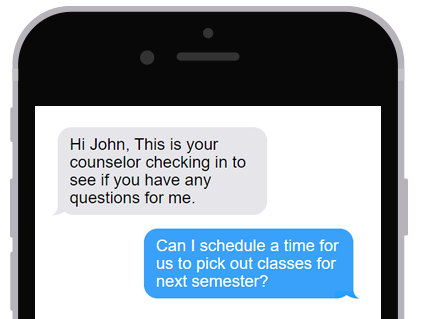

Going from high school to college is a significant change for students, and the events of 2020 caused enormous psychological harm to an already struggling generation. Counselors who show they care about their students’ success and overall experience can increase retention and graduation rates. Good counselors send regular, tactful messages to prospective and current students to check in with them. In practice, counselor check-ins often inquire whether the student has questions about their major, class load, or other essential matters.
Admission and Specific School Questions
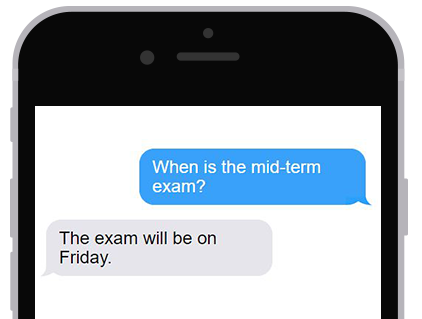

Students may have questions they either forget or were too shy to ask during a campus tour. Facilitate a more open line of communication between students and staff by allowing them to text with specific questions they may have, including especially:
- The admissions process
- Majors and classes
- Campus amenities
- Financial aid
- Housing
The more your students know and the more you proactively help them, the more comfortable they will be in applying.
Elevating the Conversation
Regarding effective communication with today’s mobile-centric youth, nothing is quicker and more convenient than texting. These are only a few of the many ways colleges and universities are already leveraging admissions texting to increase interest, boost enrollment, and improve the student’s overall experience.
If you would like to talk to a higher-education SMS expert at TrueDialog, feel free to contact us or sign up for a free trial — and start experiencing the benefits of a higher-ed texting platform in your use-case scenarios today.
 Salesforce
Salesforce



